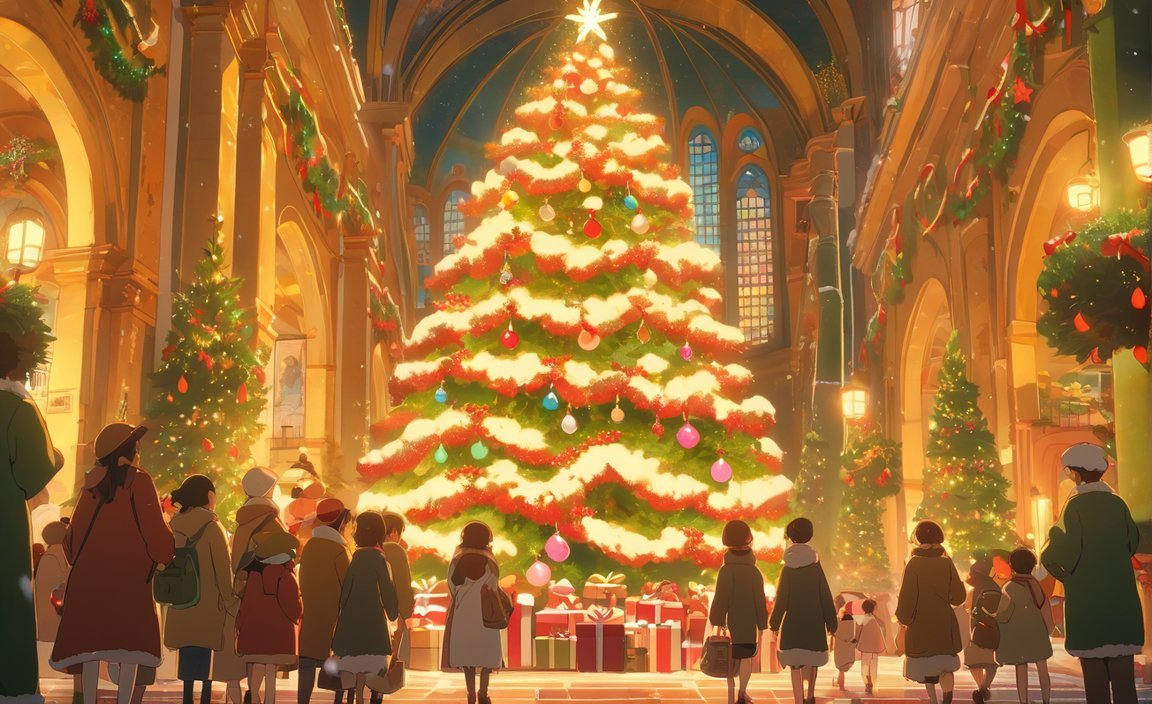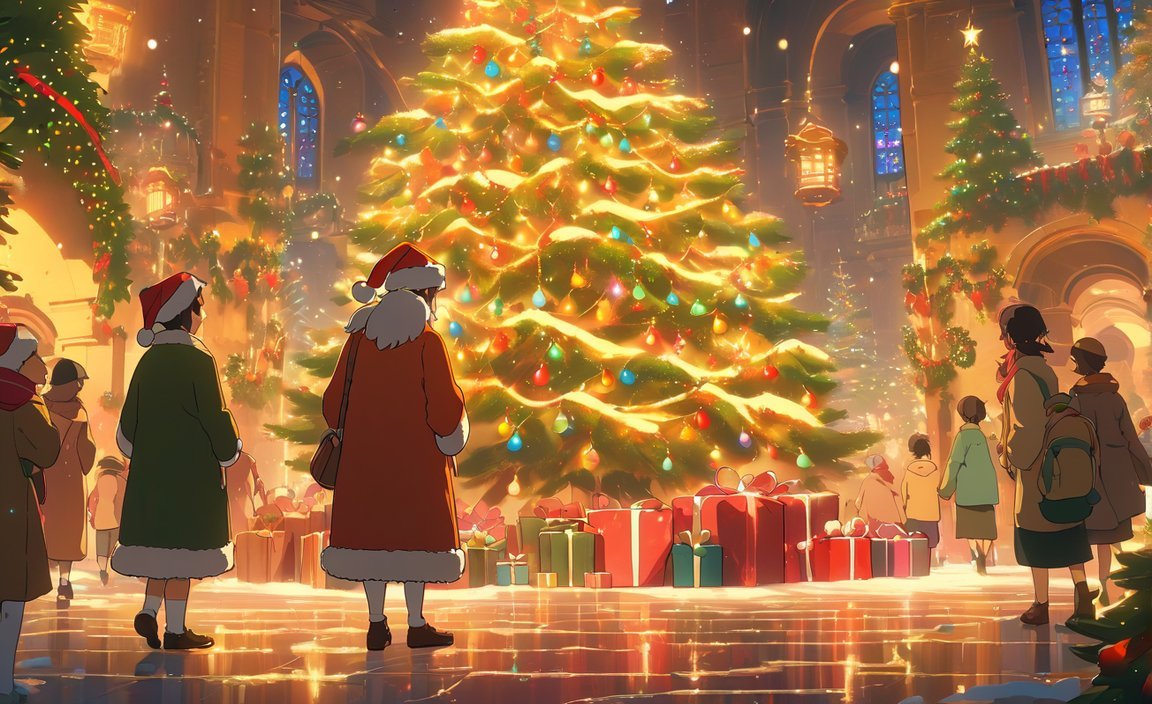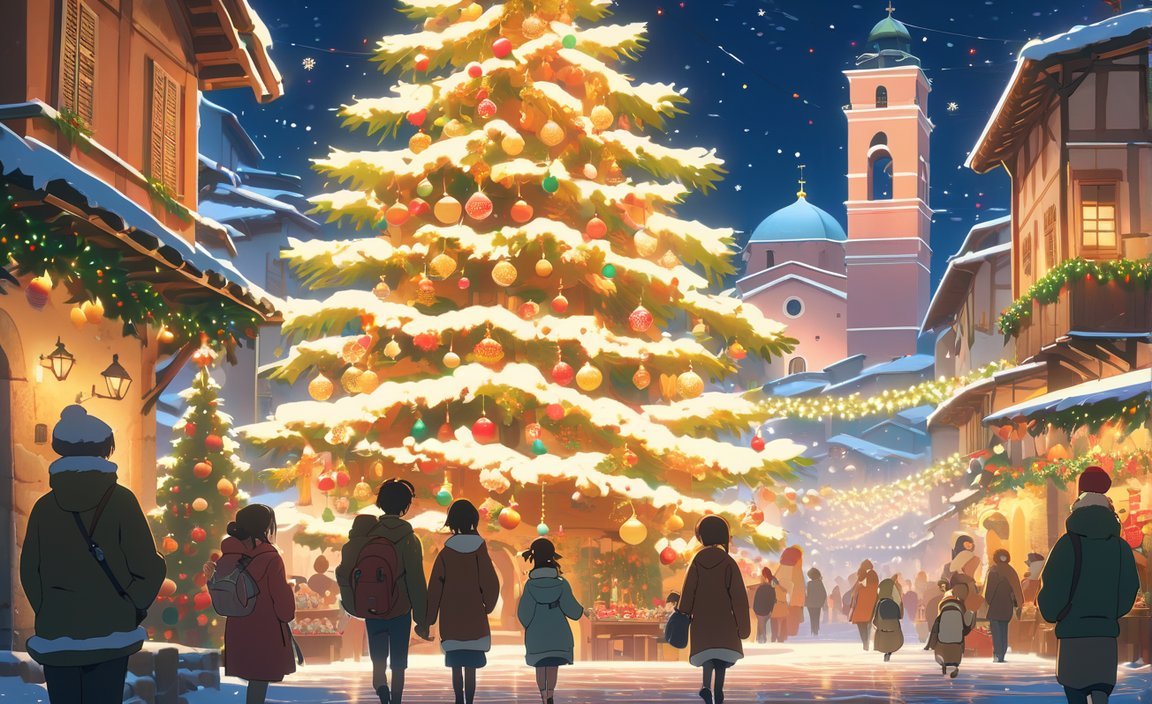Discover Captivating Christmas Traditions in Italy: Fun Facts! Dive into the enchanting world of Christmas in Italy and uncover fascinating tidbits about this festive season in one of Europe’s most culturally rich countries. From stunning decorations and mouthwatering culinary delights to intriguing rituals and lesser-known tales, this article is your ultimate guide to the captivating Christmas traditions that make Italy a must-visit during the holiday season.

Key Takeaways:
– “Buon Natale” is how you would wish someone Merry Christmas in Italy.
– Saint Nicholas visits children on December 6th, marking the start of the Christmas season.
– Nativity scenes are a major focus of Christmas decorations in Italy.
– The Christmas festivities in Italy last from December 6th until Epiphany on January 6th.
– The witch La Befana brings gifts and fills children’s stockings.
– Christmas caroling originated in Italy.
– Traditional Catholic fasting is observed on Christmas Eve, followed by festive celebrations after midnight mass.
– Babbo Natale (Father Christmas) now brings presents on Christmas Eve.
Fun facts about Christmas in Italy
Italy is known for its rich cultural heritage and vibrant traditions, and Christmas in Italy is no exception. From unique customs to mouthwatering delicacies, the holiday season in Italy is a time filled with joy and celebration. Let’s dive into some fun facts about Christmas in Italy.
Buon Natale: How Italians say Merry Christmas
When it comes to exchanging festive greetings in Italy, “Buon Natale” is the phrase of the season. This heartfelt expression translates to “Merry Christmas” and is the most common way to wish others during this magical time.
The Arrival of Saint Nicholas
While Santa Claus may be the iconic figure associated with Christmas worldwide, in Italy, Saint Nicholas takes center stage. On December 6th, which is Saint Nicholas Day, children in Italy hang their stockings with excitement. Saint Nicholas visits these children, filling their stockings with small treats, marking the official beginning of the Christmas season.
Nativity Scene: The Focus of Decorations
In Italy, Christmas decorations revolve around the Nativity scene, also known as the Presepe. These elaborate displays depict the birth of Jesus and often include miniatures of villagers, animals, and even real moss to create a lifelike atmosphere. The Presepe is a cherished tradition that adorns homes, churches, and even public spaces throughout the country.
The Twelve Days of Christmas
In Italy, the festivities extend well beyond December 25th. Italians celebrate the Twelve Days of Christmas, starting from December 6th and culminating with Epiphany on January 6th. It is on this day, also known as La Befana, that most Italians exchange gifts. This tradition of waiting until the 12th day of Christmas adds an extra layer of anticipation and excitement to the holiday season.
La Befana: Italy’s Gift-Giving Witch
Move over, Santa Claus. In Italy, children eagerly await the arrival of La Befana, a friendly witch who brings gifts during the night. Legend has it that La Befana flies on a broom and enters through the chimney, leaving presents in children’s stockings. This delightful twist on the traditional Santa Claus adds a touch of Italian charm to the holiday season.
The Birthplace of Christmas Caroling
Did you know that Christmas caroling originated in Italy? Italians have a strong musical tradition, and it comes as no surprise that Christmas caroling began in this enchanting country. Singing festive songs and spreading holiday cheer through melodious tunes is a cherished Italian Christmas tradition.
Christmas Eve: Fasting and Festive Celebrations
On Christmas Eve in Italy, a traditional Catholic fasting, known as La Vigilia, is observed. It involves abstaining from food during the day as a sign of spiritual preparation. The fast is broken after midnight mass, when families come together to celebrate with a delicious feast. This unique blend of solemnity and merriment makes Christmas Eve a truly special occasion.
Babbo Natale: Italy’s Father Christmas
While Saint Nicholas takes on the role of gift-giving in Italy, Babbo Natale, also known as Father Christmas, has become increasingly popular in recent years. Babbo Natale is believed to bring presents to children on Christmas Eve, adding a touch of modernity to the traditional Italian Christmas.
Italy weaves together history, culture, and enchantment to create a unique Christmas experience. With its focus on the Nativity scene, the arrival of Saint Nicholas, and the delightful traditions of La Befana and Babbo Natale, Christmas in Italy is a magical celebration that captivates both young and old. So, why not immerse yourself in the fascinating world of Christmas in Italy and discover the joy and wonder that it beholds? Buon Natale!
Here are some fascinating fun facts about different countries that you won’t want to miss!
- Serbia fun facts: Did you know Serbia is home to the world’s largest trumpet festival? Discover more intriguing facts about this lively country.
- Guyana fun facts: Prepare to be amazed by the stunning natural wonders of Guyana, including the breathtaking Kaieteur Falls. Click here to explore more fun facts about Guyana!
- Fun facts about Guyana: From its diverse wildlife to its vibrant music and traditions, Guyana is a treasure trove of interesting facts! Dive deeper into this fascinating country here.
- Fun facts of Sweden: Sweden is known for its stunning landscapes and unique cultural traditions. Uncover more intriguing fun facts about this Nordic gem here.
- Facts about Turkey the country: Turkey is a country rich in history and culture. Discover captivating facts about its ancient ruins, mouthwatering cuisine, and more! Click here to delve into the wonders of Turkey.
Mouthwatering Italian Christmas cuisine and delicacies
Christmas in Italy is not just about festive decorations and traditions, but also about indulging in mouthwatering cuisine and delicacies that are unique to this holiday season. From savory dishes to sweet treats, Italian Christmas food is a delight for the taste buds. So, let’s take a closer look at some of the most delicious and enticing Italian Christmas dishes that will leave you craving for more!
Italian Christmas Food: Traditional Delicacies
One of the highlights of an Italian Christmas is undoubtedly the delectable feast that awaits everyone. Traditional Italian Christmas cuisine is known for its rich flavors and heartwarming dishes that bring families together. Here are some mouthwatering delicacies you can expect to savor during the holiday season in Italy:
- Panettone: This iconic Italian Christmas cake is a must-have during the festivities. With its fluffy texture and rich flavors of dried fruits and nuts, Panettone is a delightful treat that is enjoyed by people of all ages. Whether enjoyed plain or with a cup of hot chocolate, this sweet bread-like cake is a Christmas staple in Italian households.
- Pandoro: Another popular sweet bread that graces Italian Christmas tables is Pandoro. This golden and buttery cake is traditionally dusted with powdered sugar, resembling a snowy mountain. Sliced into star-shaped pieces, Pandoro is perfect for sharing and the perfect accompaniment to a cup of coffee or a glass of sweet wine.
- Torrone: If you have a sweet tooth, then Torrone is sure to satisfy your cravings. This traditional Italian nougat is made with honey, sugar, egg whites, and toasted almonds. Its chewy yet soft texture, along with the delightful combination of sweetness and nuttiness, makes Torrone an irresistible treat during the Christmas season.
- Panforte: Hailing from the beautiful city of Siena, Panforte is a dense and aromatic fruitcake that dates back to the Middle Ages. Packed with nuts, dried fruits, and fragrant spices such as cinnamon and cloves, this traditional Italian Christmas dessert is bursting with rich flavors and textures.
- Struffoli: These small, deep-fried dough balls soaked in honey and adorned with colorful sprinkles are a festive favorite in Italy. Struffoli are often arranged in the shape of a Christmas tree and make for a visually appealing and scrumptious treat that is enjoyed by both children and adults alike.
- Cannoli: Originating from Sicily, these crispy pastry tubes filled with sweetened ricotta cheese are a beloved Christmas dessert in Italy. The combination of crunchy shell and creamy filling, often studded with chocolate chips or candied fruit, makes Cannoli an absolute delight for dessert lovers.
- Baccalà: Christmas Eve in Italy is often marked by the tradition of consuming seafood dishes, and one of the most popular choices is Baccalà. This salted and dried codfish is typically prepared in various ways, such as stewed with tomatoes and olives or fried until golden and crispy. Baccalà is a true feast for the senses, showcasing the culinary prowess of Italian cooks.
Key Takeaways:
- Italian Christmas cuisine is renowned for its delicious and diverse range of dishes.
- Traditional delicacies include Panettone, Pandoro, Torrone, Panforte, Struffoli, Cannoli, and Baccalà.
- These dishes incorporate a variety of flavors and textures, from sweet and fruity to savory and crispy.
- Italian Christmas food brings families together and adds to the festive spirit of the holiday season.
Sources:
– Italy Foodies – Christmas Food in Italy: Traditional Holiday Foods and Recipes
– Cucina By Elena – Traditional Italian Christmas Food in Italy
Fascinating Regional Variations in Christmas Celebrations
Italy is a country rich in culture and traditions, and Christmas is no exception. While there are common customs and practices observed throughout the country, what truly makes Christmas in Italy captivating are the fascinating regional variations in celebrations. Let’s take a closer look at some of these unique traditions that add an extra sparkle to the holiday season.
1. Italian Nativity Scenes: From Simple to Spectacular
Nativity scenes, known as “presepe” in Italian, hold significant importance in Italian Christmas traditions. While you may be accustomed to seeing Christmas trees adorning homes and public spaces during the holiday season, in Italy, nativity scenes often take precedence. These intricate displays depict the birth of Jesus and are crafted with impressive attention to detail. From miniature versions placed in living rooms to life-sized scenes in town squares, each region showcases its own artistic interpretation of the nativity.
2. Regional Christmas Caroling: Unique Melodies Fill the Air
Christmas caroling holds deep-rooted origins in Italy, with the country being credited for its creation. The tradition is said to have been started by none other than St. Francis of Assisi, who also created the first nativity scene. As you travel through different regions of Italy during the holiday season, you’ll witness the unforgettable spectacle of regional variations in Christmas carols. One particularly enchanting tradition is the performance of carols by zampognari, Italian bagpipers who dress up as shepherds and parade through towns, serenading locals and visitors alike with their melodic tunes.
3. Live Nativity Performances: Bringing the Christmas Story to Life
Many Italian cities go above and beyond to celebrate Christmas by organizing live nativity performances. These vibrant reenactments of the nativity story are often put together by local churches or dedicated community groups. Strolling through the streets of Italian towns during the holiday season, you may stumble upon a living nativity scene. From actors in period costumes to live animals, these performances bring the spirit of Christmas to life and create a truly immersive experience for both locals and tourists.
4. Regional Santa Claus: From Babbo Natale to St. Nicholas
While the world knows Santa Claus as the jolly man in a red suit, in Italy, different regions have their own unique versions of this beloved figure. In Northern Italy, children excitedly await the visit of “Babbo Natale,” who brings gifts and fills their hanging stockings on December 6th, which is celebrated as St. Nicholas Day. In some areas, children write letters to Babbo Natale, expressing their wishes for Christmas. The diversity in these regional variations adds charm and excitement to the festive season.
5. Regional Christmas Food: Celebrating With Delicious Delicacies
Christmas in Italy is a time of indulgence, and the cuisine reflects this joyful spirit. While there are common traditional dishes like baccalà (salted and dried codfish) and panettone (a fruitcake), regional variations in Christmas food add a delightful twist to the celebrations. From the coastal regions feasting on seafood delicacies to the mountainous areas savoring hearty meats and cheeses, each region has its own unique culinary traditions. Exploring the diverse flavors and dishes adds an element of intrigue to your Italian Christmas experience.
Key Takeaways:
- Italy’s Christmas traditions are filled with regional variations that make each celebration unique.
- Nativity scenes, or “presepe,” are highly revered and take precedence over Christmas trees in Italian homes and public spaces.
- Christmas caroling originated in Italy and holds deep cultural roots.
- Many Italian cities organize live nativity performances, bringing the Christmas story to life.
- Different regions of Italy have their own versions of Santa Claus, such as “Babbo Natale” and St. Nicholas.
- Regional variations in Christmas food add a delicious twist to the festive season.
Sources:
Intriguing Italian Christmas rituals and customs
Italy is a country that never fails to captivate with its rich cultural traditions, and Christmas is no exception. From enchanting folklore to ancient customs, the celebrations in Italy are steeped in history and charm. Let’s dive into some intriguing Italian Christmas rituals and customs that will transport you to the magical world of festive cheer.
Key Takeaways:
- St. Nicholas and Santa Lucia: St. Nicholas visits the northern parts of Italy on December 6th, leaving treats and small gifts in children’s stockings. On December 13th, Santa Lucia brings presents for the well-behaved kids.
- Babbo Natale and Befana: Babbo Natale, Italy’s version of Santa Claus, brings gifts to children all over Italy on either Christmas Eve or Christmas Day. However, it is La Befana, a friendly witch, who fills stockings with gifts on January 6th.
- Epiphany: The festivities in Italy last from about the 6th of December until Epiphany, the 6th of January, marking the end of the Christmas season. Most Italians exchange gifts on the 12th day of Christmas, January 6th.
- Nativity Scenes: Nativity scenes, known as “presepe,” hold great significance in Italy. These elaborate and detailed representations of the birth of Jesus can be found in homes, churches, and public squares.
- Live Nativity Scenes: Italy takes nativity scenes a step further with live performances. These immersive experiences recreate the scenes from the biblical story, often involving locals dressed as the characters.
- Origin of Christmas Caroling: Did you know that Christmas caroling originated in Italy? This delightful tradition has its roots in Italy, where carols were played on zampognari, the country’s version of bagpipes.
- Christmas Eve Feast: On Christmas Eve, many Italians observe a traditional Catholic fasting called La Vigilia. This fast is followed by a festive feast that features a variety of delicious bread and sweet treats.
- Regional Variations: Just like many other aspects of Italian culture, Christmas traditions have fascinating regional variations. Different parts of Italy have their own versions of Santa Claus or gift-bringers, adding a unique touch to the celebrations.
- Delicious Christmas Cuisine: Italian Christmas cuisine is a feast for the senses. From the iconic Panettone, a cake filled with dried fruits and nuts, to the golden and buttery Pandoro, there’s no shortage of delectable treats to indulge in during the festive season.
- No Meat on Christmas Eve: It’s customary in Italy to abstain from eating meat on Christmas Eve. Instead, families celebrate with a variety of vegetarian dishes, bread, and sweets that add to the spirit of the holiday season.
With its enchanting customs and mouthwatering cuisine, Christmas in Italy is a time of joy and celebration. Whether you’re fascinated by the elaborate nativity scenes or the regional variations in traditions, there’s always something intriguing to discover about Christmas in this beautiful country.
Sources:
– Travels With The Crew: Christmas in Italy- fun facts for kids
– Primary Facts: Christmas in Italy: Facts About Italian Christmas Customs

FAQ
Q1: When do Christmas festivities start in Italy?
A1: Christmas festivities in Italy start on December 8th, which is the Feast of the Immaculate Conception. Italians attend mass services and begin decorating their homes on this day.
Q2: What is the significance of nativity scenes in Italy?
A2: Nativity scenes, or Presepe, hold more importance than Christmas trees in Italy. They are considered incredibly important and can be found in homes and public spaces throughout the country.
Q3: Who is credited with creating the first nativity scene and starting the tradition of Christmas caroling in Italy?
A3: St. Francis of Assisi, an important figure in Christianity, is credited with creating the first nativity scene and starting the tradition of Christmas caroling in Italy.
Q4: Do Italians have any unique traditions during the Christmas season?
A4: Yes, many cities in Italy organize live nativity scenes during Christmas, often involving dozens or even hundreds of people. Additionally, Zampognari, the Italian version of bagpipes, play Christmas carols throughout the holiday season.
Q5: What are some traditional Italian Christmas foods?
A5: Traditional Italian Christmas food varies by region and family, but it often includes dishes such as swordfish topped with puttanesca sauce and hearty soups.
- Star Ring Trends: Etsy vs Amazon - March 28, 2025
- Boost Pollinator Habitats: Baby Blue Eyes Sustainable Farming Guide - March 28, 2025
- Protect Big Black Bears: Effective Conservation Strategies - March 28, 2025
















